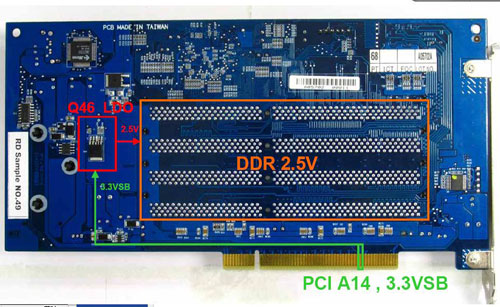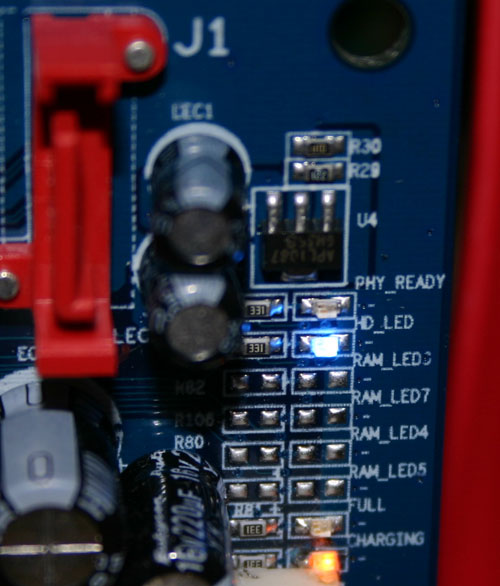Gigabyte's i-RAM: Affordable Solid State Storage
by Anand Lal Shimpi on July 25, 2005 3:50 PM EST- Posted in
- Storage
i-RAM's Limitations
Since your data is stored on a volatile medium with the i-RAM, a loss of power could mean that everything stored on the card would be erased with no hopes for recovery. While a lot of users may keep their computers on 24/7, there are always occasional power outages that would spell certain doom for i-RAM owners. In order to combat this possibility, Gigabyte outfitted the i-RAM with its own rechargeable battery pack.
There are only three conditions where the i-RAM runs off of battery power:
1) When the i-RAM is unplugged from the PCI slot;For whatever reason, unplugging the i-RAM from the PCI slot causes its power consumption to go up considerably, and will actually drain its battery a lot quicker than the specified 16 hours. We originally did this to test how long the i-RAM would last on battery power, but then were later told by Gigabyte not to do this because it puts the i-RAM in a state of accelerated battery consumption.
2) When the power cable is unplugged from your power supply (or the power supply is disconnected from your motherboard; and
3) When the power button on your power supply is turned off.
For the most part, the i-RAM will always be powered. Your data is only at risk if you have a long-term power outage or you physically remove the i-RAM card.
If you run out of battery power, you will lose all data and the i-RAM will stop appearing as a drive letter in Windows as soon as you power it back up. You'll have to re-create the partition data and copy/install all of your files and programs over again.
The card features four LEDs that indicate its status: PHY_READY, HD_LED, Full and Charging.











133 Comments
View All Comments
simpletech - Tuesday, July 26, 2005 - link
I think another possible use (besides certain kinds of servers, like mail servers), is for video capture. The size is a bit small, but if you were capturing segments of footage, it might work. And the price could be reasonable.BikeDude - Tuesday, July 26, 2005 - link
"but 32-bit Windows can't use more than 4GB of RAM, including the swap file size."First of all... "Swap file" is a misnomer. We talked about "swap file" back in the Windows 3.1 days when the OS would swap a process' entire memory space to the *swap* file.
These days the OS will read/write selected pages of a process' memory from/to the cache manager (who may or may not elect to use the disk to get to the physical pagefile). *Paging*, not "swapping". Executables and libraries are memory mapped and thus start their lives with all pages firmly on disk (so a big executable won't necessarily load slow, but many small DLLs OTOH just might).
I don't have Windows XP in front of me, but my 32-bit Windows 2003 Standard ed. with 4GB memory and 1GB pagefile certainly doesn't seem affected by the limitation you mention. Enterprise edition can address even more physical memory... Each process is still limited to a 2GB virtual address space though. (32-bit processes marked capable of such will gain a 4GB virtual address space under 64-bit Windows)
I realise that XPSP2, despite PAE, is limited to 4GB physical memory (http://blogs.msdn.com/carmencr/archive/2004/08/06/...">http://blogs.msdn.com/carmencr/archive/2004/08/06/..., but pagefile as well? Nah, sounds iffy.
JarredWalton - Tuesday, July 26, 2005 - link
Without PAE (or something similar), 32-bit OSes are indeed limited to 4GB of RAM. This is what is being referred to, as PAE is limited to Intel and I don't believe it's available on non-Server versions of Windows. (Correct me if I'm wrong, but PAE is pretty much only on Xeons, right?)You're right that it's paging instead of swapping now, but there's really not much difference between the two. Basically, you put data onto the HDD in order to free up physical RAM, on the assumption that the least recently used data that was moved to the HDD won't be accessed again for a while.
JarredWalton - Tuesday, July 26, 2005 - link
Anyway, I've modified the comment to reflect the original intent. If you're running PAE and Server, it's a whole different ball game for high memory systems.Penth - Tuesday, July 26, 2005 - link
Wow, my friend and I talked about the possibilities for these things several times. But at 3x the initial price and not the performance increase I would have expected, the techie in me is disappointed. My wallet is happy though.StanleyBuchanan - Tuesday, July 26, 2005 - link
I wonder what the issue is with RAID that Anand comments on.... seems odd that it would behave differently than a HD in this respect and cause problems...I would love to have 12gb or more... which is enough for Windows XP, a productivity suite, and a modern game... anything more could be run from NAS
Zan Lynx - Sunday, July 31, 2005 - link
Probably something to do with the PCI bus power. Perhaps two of these cards take more juice than the bus expects to provide while on standby.phaxmohdem - Monday, July 25, 2005 - link
I saw someone else posting as well, but I would very much like to see some database performance numbers from this device, as well as perhaps a web-serving benchmark.xTYBALTx - Monday, July 25, 2005 - link
How some FPS benchies?GTMan - Monday, July 25, 2005 - link
I laughed when I saw that line :) A very interesting device and I look forward to where this goes in the future. Your "Final Words" could use a bit of brevity.